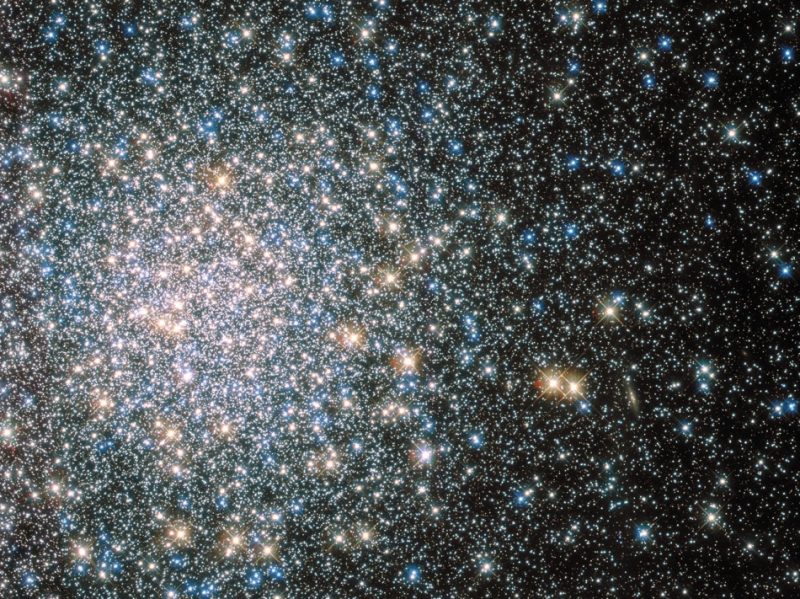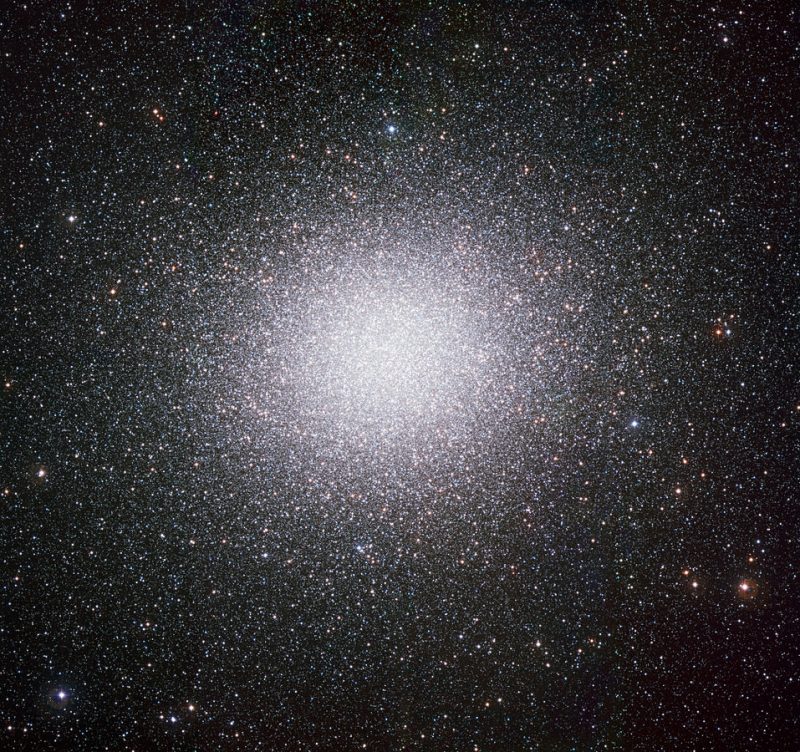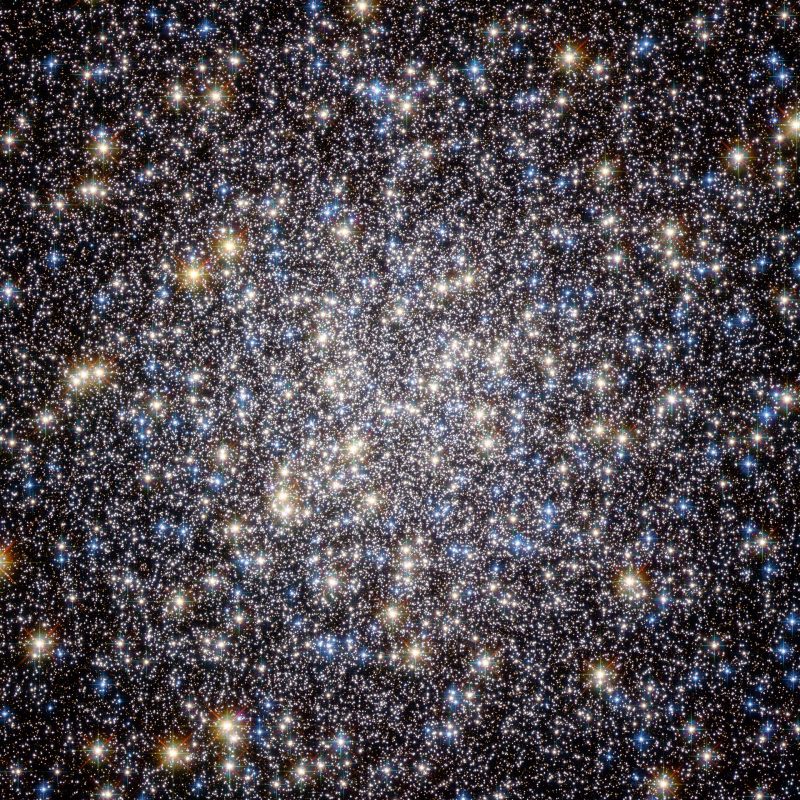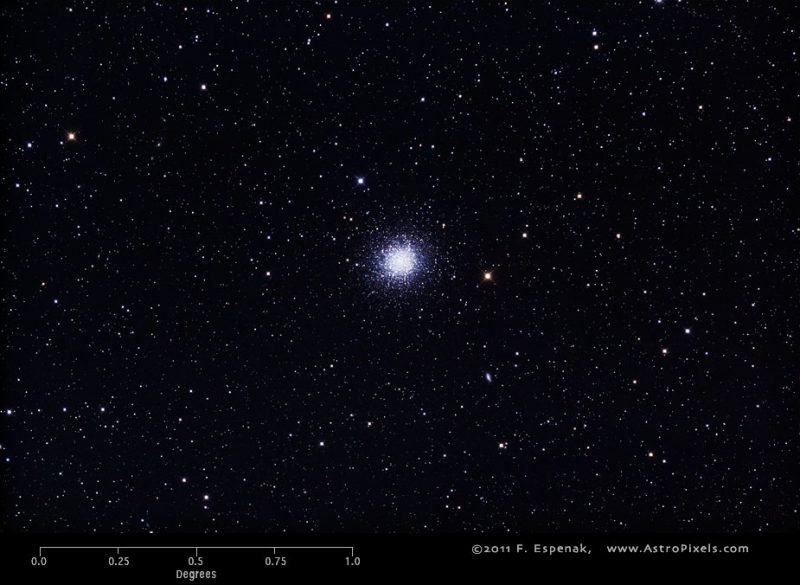
A globular cluster contains old stars
Globular clusters are tightly packed, symmetrical collections of stars. And they orbit mostly in the extended stellar halos surrounding most spiral galaxies. Plus, globular clusters contain some of the oldest stars in a galaxy, forming early in its history. Could it be that – when it was first forming – a spiral galaxy was once a shapeless cloud of gas and dust? And could its first stars have collected into globular clusters? Could these clusters have stayed put in the halo around a galaxy’s center? While the rest of the spinning galaxy flattened out and formed spiral arms? Because, that scenario explains why globular clusters orbit in a galaxy’s halo and contain its oldest stars.
But the fact is, no one knows precisely how globular clusters formed. Or what role, if any, they played in the development of galaxies. We know globular clusters are the oldest, largest and most massive type of star cluster. And globular clusters contain the oldest stars. Their age is determined by their almost complete lack of what astronomers call metals, the heavier elements forged in star interiors. Because the early universe, before the first stars and galaxies were born, contained only hydrogen and helium.

The difference between a globular cluster and an open cluster
Globular clusters are big, symmetric and old. They can reach 300 light-years in diameter and contain 10 million stars. On the other hand, open star clusters, contains sibling stars, scattered through the disk of our galaxy and presumably other galaxies.
Globular star cluster are very symmetrical in shape, and are densest toward their centers. Open star clusters are irregular in shape and loosely grouped together.
Globular clusters orbit in the halo of our galaxy. Plus, center around the galaxy’s core and expanding above and below the galactic disk. Open star clusters tend to orbit within the disk.
Globular star clusters contain hundreds of thousands of stars. Yet some globular clusters, like Omega Centauri, contain millions of stars. Open star clusters contain only hundreds of stars.

The Milky Way has over 150 globular clusters
Our own Milky Way has over 150 globular clusters, with perhaps more, hidden by galactic dust. The Andromeda galaxy (M31), our neighboring spiral galaxy, appears to have around 300 globular clusters.
Some elliptical galaxies have globular clusters. Such as M87, a giant elliptical galaxy with over 12,000 globular clusters. As a matter of fact, over 1,000 globular clusters have been observed telescopically so far. By the way, M87 is home to the supermassive black hole famously imaged by the Event Horizon Telescope in 2019.
In fact, the orbits of globular clusters are highly eccentric and inclined to the galactic plane. They take about a few hundred million years to complete a single orbit since they are in the “outskirts” of a galaxy. A globular cluster looks like a fuzzy ball in a telescope. Also, there are individual stars at the periphery merging into a solid ball of light towards the center. However, this is simply because the stars are so close together that they can’t be resolved individually telescopically.
At the center of a globular cluster, stars may reach a density of between 100 and 1,000 stars per cubic parsec. That’s in contrast to the density of stars near our sun, estimated at about 0.14 star per cubic parsec. Your night sky would full of stars if you lived on a planet orbiting a star in a globular cluster!
Globulars are ancient stars
The stars in globular clusters are the galaxy’s most ancient inhabitants, comprising a population of what astronomers call Population II stars. Their estimated ages are between 11 and 13 billion years old, making them almost as old as the galaxy itself. Not surprisingly, many of these ancient stars have evolved into huge, bloated red giant stars. Which our sun will do in a few billion years.
The stars in globular clusters are extremely metal-poor. Which is to say, they have tiny amounts of materials heavier than helium compared to the surrounding interstellar medium. All elements heavier than helium are what astronomers refer to as “metals”. And the heavier elements made inside stars ends up in the interstellar medium via supernova explosions. So, these old stars are expected to lack metals. In other words, Population II stars consist almost exclusively of hydrogen and helium, the materials present in the early universe.
However, globular clusters can have heavier metals, like those in stars that formed more recently. In particular, excesses of sodium, carbon, oxygen and aluminum, with heavier metals such as strontium, yttrium, barium and europium are present in some clusters. These anomalies remain a mystery but astronomers do have a few theories to explain this. Such as, the early presence of supermassive stars going supernova in the early universe.

Messier 13 is the best globular cluster in the Northern Hemisphere
The most famous globular cluster in the Northern Hemisphere is M13 in the constellation of Hercules. Another name for M13 is the Great Globular Cluster, discovered by Edmond Halley in 1714. Charles Messier later added it into his famous Messier catalog in 1764. In amateur telescopes, it is a small fuzzy patch of light, some 22,000 light-years from Earth. At the center of this cluster, stars orbit so closely that occasionally they collide. Furthermore, their deaths lead to the creation of new stars known as “blue stragglers.” This stellar population is the only type of newer stars in globular clusters.
Some other great globular clusters
Other globular clusters of note are M22 in Sagittarius – one of the brightest in the sky – M5 in Serpens and M12 in Ophiuchus. Many of the night sky’s biggest and brightest globular clusters are best viewed on spring nights and often feature in so-called “Messier Marathons.”
Furthermore, there are two fabulous globular clusters in the Southern Hemisphere. Omega Centauri, also known as NGC 5139, is visible to the naked eye to observers at low northern latitudes and in the southern hemisphere. Omega Centauri contains approximately 10 million stars and is about 16,000 light-years away. As well as, 47 Tucanae, noted for having a small very bright and dense core. In fact, it is one of the most massive globular clusters in the galaxy, containing millions of stars.
Even the smallest telescopes reveal globular clusters as a wonderful sight. However, a large telescope resolves individual stars toward their centers.

Bottom line: Globular clusters are spherical collections of stars, orbiting mostly in the halo of spiral galaxies. Our Milky Way galaxy has over 150 globular clusters containing some of our galaxy’s oldest stars.











